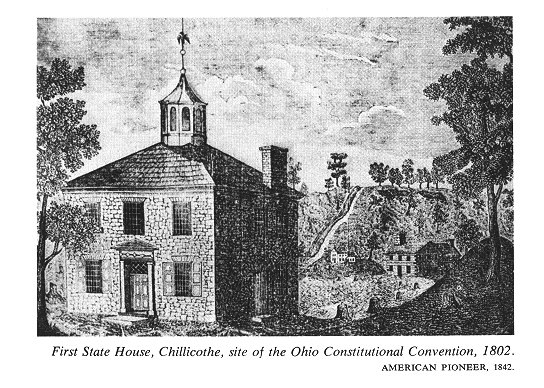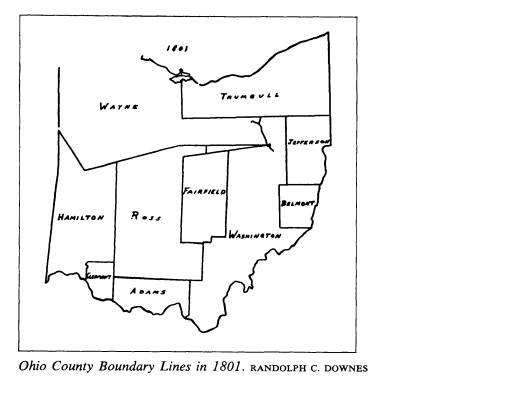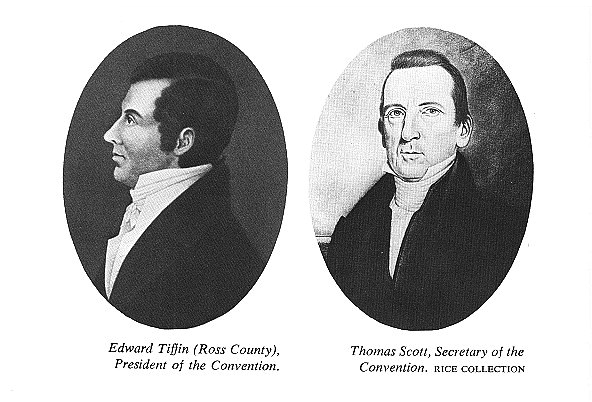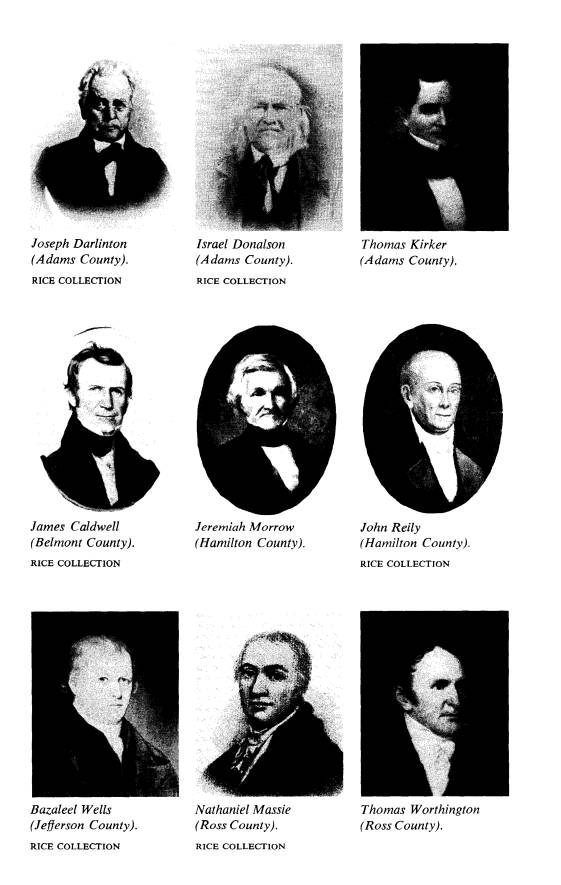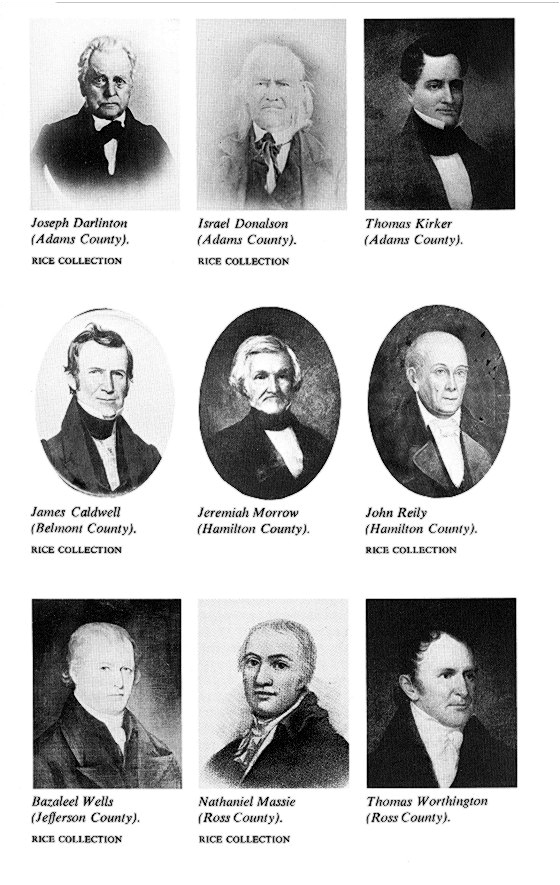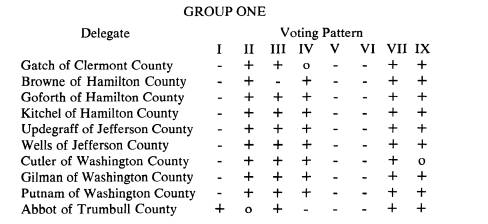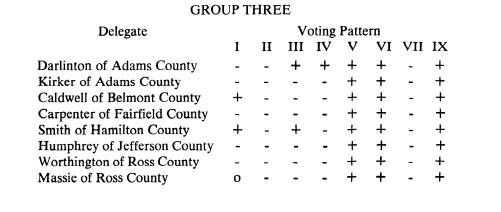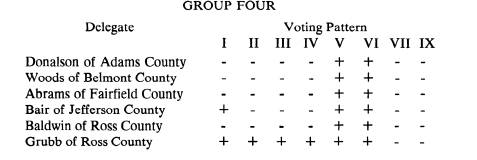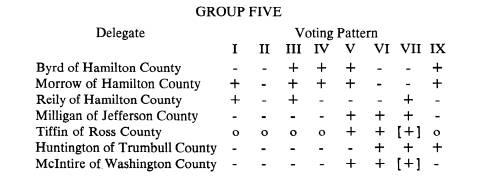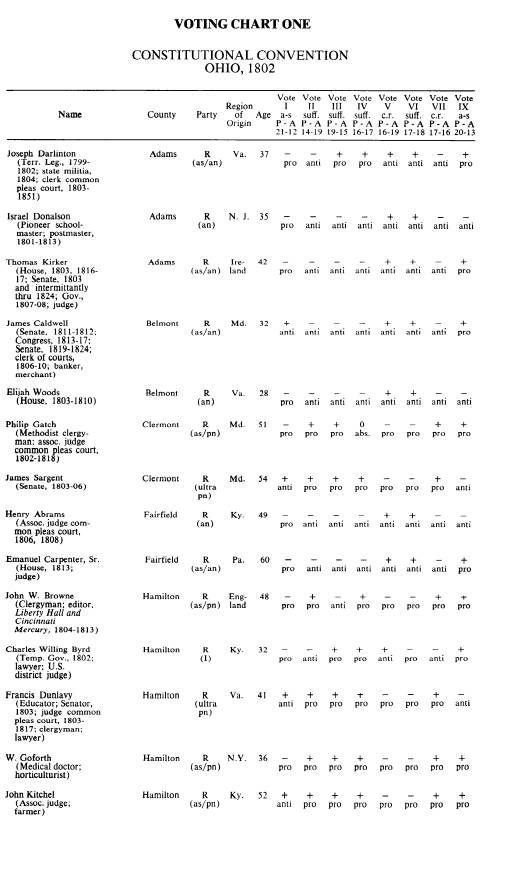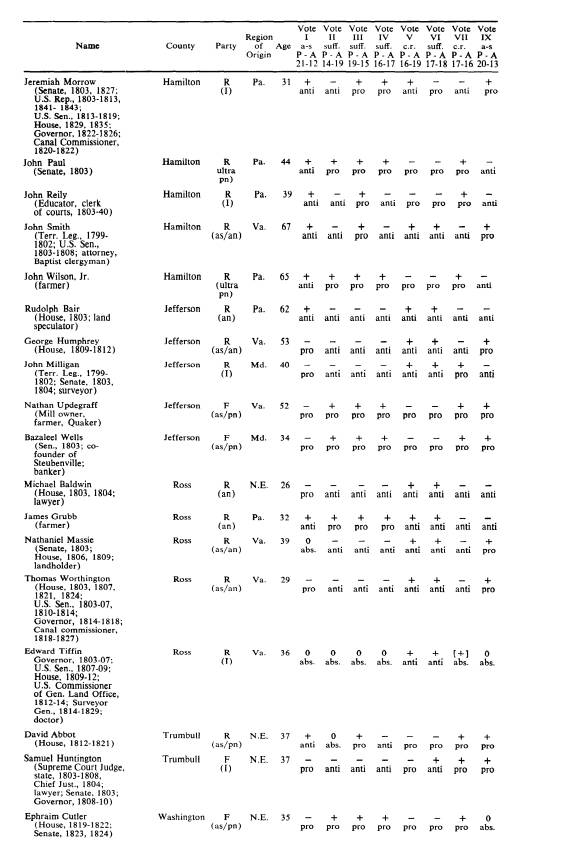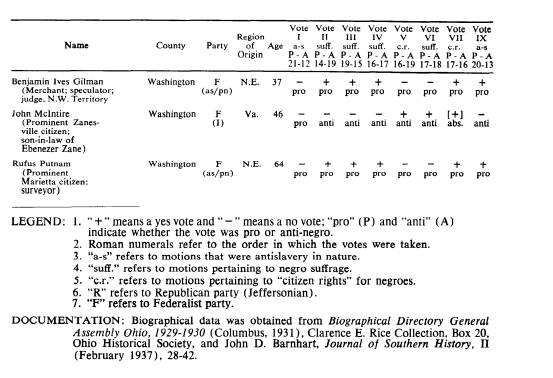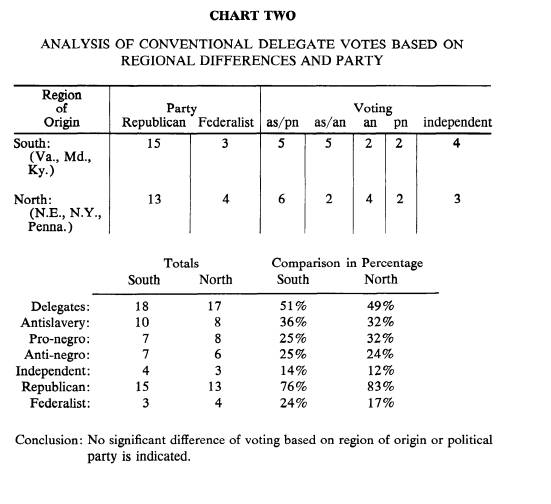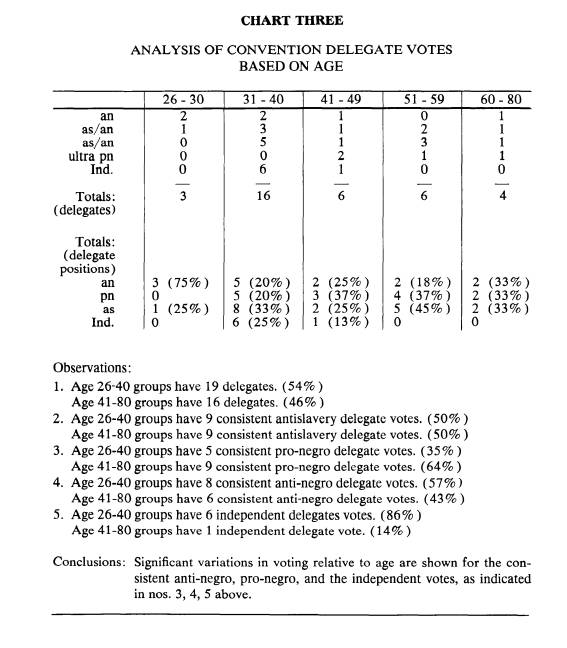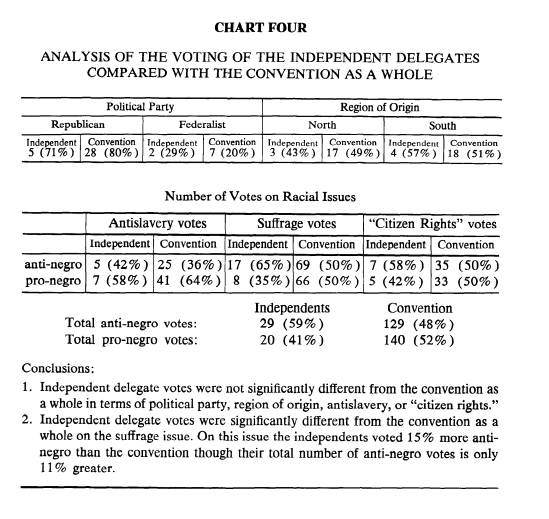Ohio History Journal
- 1
- 2
- 3
- 4
- 5
- 6
- 7
- 8
- 9
- 10
- 11
- 12
- 13
- 14
- 15
- 16
- 17
- 18
- 19
- 20
- 21
- 22
- 23
HELEN M. THURSTON
The 1802 Constitutional Convention
and Status of the Negro
What does the 1802 Ohio constitution
say regarding freedom, suffrage, and "citizen
rights" for negroes and mulattoes?1
How were decisions made at the constitutional
convention? Who were the
decision-makers?
Since even today confusion exists in
historical studies on these questions, it is
hoped that answers, in some degree, can
be obtained from a vote by vote study of
the eight major motions concerning the
negro that were taken up at the convention.2
Even though a detailed account of the
proceedings was not kept that would tell us
how decisions were made, it is possible
to determine from the official journal and
from biographical data that has not been
widely used by previous researchers what
decisions were made, who voted in what
way, and what outside factors were not
influencing the vote. This study then
consists of an analysis of the voting patterns
that led to the final wording of the
constitution relative to the status of negroes and
mulattoes. From these patterns certain
quantitative inferences are made that appear
to be valid. Since personal motivation
of the delegates concerning particular votes
is not known in most cases, qualitative
judgments are avoided.
One historian who has written in more
detail than most others on the voting at
the convention concludes from his
analysis that the delegates were "more controlled
by feeling than by reason."3 At
times the voting does seem to be contradictory and
1. The term "citizen rights"
is used within quotation marks to indicate that it is a coined
term used to refer to general civil
rights normally granted to white citizens in the early 1800's.
In the journal of the convention these
rights were not designated by a specific adjective but
were referred to only as "section
seven."
2. Some general studies of the Ohio
Constitutional Convention of 1802 are included in
the following works: Richard Frederick
O'Dell, "The Early Antislavery Movement in Ohio"
(unpublished Ph.D. dissertation,
University of Michigan, 1948), 96-128; William T. Utter, The
Frontier State, 1803-1925 (Carl Wittke, ed., The History of the State of Ohio,
II, Columbus,
1942), 3-31; Julia Perkins Cutler, Life
and Times of Ephraim Cutler: Prepared from His
Journals and Correspondences. . . (Cincinnati, 1890), 66-82; Frank U. Quillin, The
Color Line
in Ohio: A History of Race Prejudice
in a Typical Northern State (Ann
Arbor, 1913), 13-20;
Daniel J. Ryan, History of Ohio: The
Rise and Progress of an American State (Emilius O.
Randall and Daniel J. Ryan, History
of Ohio, III, New York, 1912), 111-141; Alfred Byron
Sears, Thomas Worthington: Father of
Ohio Statehood (Columbus, 1958), 94-112; Charles
B. Galbreath, History of Ohio (Chicago,
1925), II, 13-34. See also Ruhl Jacob Bartlett, "The
Struggle for Statehood in Ohio," Ohio
Archaeological and Historical Publications, XXXII
(1924), 494-505; John D. Barnhart,
"The Southern Influence in the Formation of Ohio,"
Journal of Southern History, III (1937), 28-42.
3. Quillin, Color Line in Ohio, 13-20.
Mrs. Thurston is the Managing Editor of Ohio
History.
|
emotionally motivated, and this may be so because of the complexity of the problem. There were three separate issues being decided and each issue involved various shades of opinion. Votes were taken on (1) the bill of rights, especially as applied to freedom for negroes and mulattoes; (2) elector or voter qualification, and (3) "citizen rights," especially as applied to negroes and mulattoes. Motions were considered on these issues in a logical order. First the decision was made not to admit slavery in any form. If there were to be only free white and black men in Ohio, the next decision to be made was who should have suffrage? On that question, the convention decided that the blacks were not to be given the vote or be counted for electoral purposes. Finally, the decision was made concerning what rights and privileges accorded white citizens should be denied negroes. On this issue the constitution was allowed to remain silent.
I In response to authorization given "the people of the eastern division of the territory of the northwest of the River Ohio," on April 30, 1802, thirty-five delegates were chosen from nine counties in the territory, representing more than 45,000 residents. The delegates met in Chillicothe on November 1, 1802, for the purpose of drawing up a constitution for the new state which they designated "Ohio."4 At the time of the convention the most populated regions of the territory were around the principal cities: Cincinnati (Hamilton County had ten delegates), Chilli- cothe (Ross County had five delegates), Steubenville (Jefferson County had five delegates), and Marietta (Washington County had four delegates). Northeastern and eastern areas were represented by two delegates from Trumbull County and by two
4. United States Statutes at Large, Vol. II, 173; Annals of Congress, 7 Cong., 1 Sess., 268, 275, 294, 295-97, 1252, 1349-51; Ryan, History of Ohio, 106. |
|
delegates from Belmont County. Southern regions were represented by two delegates from Clermont and by three from Adams County. Central Ohio was represented by two delegates from Fairfield County. No representatives were sent from Wayne County in the northwestern part of the territory because it had been excluded from the enabling act, since the greater part of it lay outside the geographical limits set for the state.5 About seven professions or combinations of one or more were repre- sented by this group of delegates: many were or became legislators, three educators, two doctors, seven lawyers, land developers, three clergymen, and two farmers. The youngest was a spirited lawyer Michael Baldwin at twenty-six and the oldest was the prominent Baptist John Smith at sixty-seven. (See Voting Chart One, p. 31.) In formulating the bill of rights article many of the general principles found in the United States Bill of Rights were repeated with slight rewording, but many of the specific provisions for choosing elective officials and the duties and responsibilities thereof were tailor-made in Chillicothe. Even though they were especially designed for Ohio's problems, they were kept within acceptable bounds established by the other states.6 At the time of the convention there were only a reported 337 negroes in the territory, and the bulk of these was claimed by one researcher to have been in Wayne County.7 The delegates were thus asked to decide upon principles governing the status of negroes before the lawmakers could know what intra and inter-state racial problems statehood would bring; indeed, even before a general consensus was found concerning what role the free black man should have in a nonslave-holding society. The thirty-five delegates who were given the charge to decide on the fundamental
5. Ibid. 6. Ibid.; see also Barnhart, "Southern Influence in Ohio," 38-39, 42. 7. Quillin, Color Line in Ohio, 18. |
|
aspects of the Ohio constitution were as follows in alphabetical order by county: Adams: Joseph Darlinton, Israel Donalson, Thomas Kirker Belmont: James Caldwell and Elijah Woods Clermont: Rev. Philip Gatch and Joseph Sargent Fairfield: Henry Abrams and Emanuel Carpenter Hamilton: Rev. John W. Browne, Charles Willing Byrd, Francis Dunlavy, Dr. W. Goforth, John Kitchel, Jeremiah Morrow, John Paul, John Reily, Rev. John Smith, John Wilson Jefferson: Rudolph Bair, George Humphrey, John Milligan, Nathan Updegraff, Bazaleel Wells Ross: Michael Baldwin, James Grubb, Nathaniel Massie, Dr. Edward Tiffin (president of the convention), Thomas Worthington Trumbull: David Abbot, Samuel Huntington Washington: Ephraim Cutler, Benjamin Ives Gilman, John McIntire, Rufus Putnam As soon as the delegates convened, various committees were appointed to write specified portions of the constitution. Under the rules adopted each article and sec- tion, before it was deemed to be passed, was to be given three general readings before the convention as a whole, thereby allowing opportunity for change and/or compromise.8 On November 4 a committee of nine was appointed to prepare a bill of rights. Six of the nine counties were represented on this important committee:9 Hamilton County by Goforth (antislavery, pro-negro), Dunlavy (ultra pro-negro), and Browne (antislavery, pro-negro)
8. An easily accessible copy of the journal of the first constitutional convention is in Ohio Archaeological and Historical Publications (1897), V, 80-132. See also Journal of the Con- vention of the Territory of the United States North-West of the Ohio (Chillicothe, 1802). 9. Ohio Historical Publications, 90. |
|
Ross County by Baldwin (anti-negro) and Grubb (anti-negro) Belmont County by Woods (anti-negro) Jefferson County by Updegraff (antislavery, pro-negro) Washington County by Cutler (antislavery, pro-negro) Adams County by Donalson (anti-negro) The designations of voting characteristics are derived from the votes taken on the eight vote counts given in the journal of the proceedings of the convention. (See Voting Chart One for biographical data and voting record.) To be "antislavery, pro-negro" a delegate would have voted for the qualifications in the antislavery motions on votes I and IX as well as pro-negro on votes VI and VII, the suffrage and "citizen rights" motions. To be "ultra pro-negro" a delegate would have voted for the interest of the negro on the suffrage and "citizen rights" motions but against the qualifications in the antislavery section of the bill of rights article in votes I and IX. The general statement against slavery in section one of the article, in their estimation, apparently did not need special restrictions for either whites or negroes. To be "anti-negro" (but not necessarily pro-slavery) the delegate would have voted against the negro on suffrage vote VI, the "citizen rights" vote VII, and the antislavery |
Ohio Constitutional Convention 21
vote IX. Two categories, the
"anti-slavery, anti-negro" and "independent" groups
were not represented on the bill of
rights committee. To have the first designation
the delegate would have voted pro-negro
on the antislavery votes I and IX but against
him on the suffrage and "citizen
rights" votes VI and VII. On the basis of these
designations, it can be seen that the
bill of rights committee members were pro-negro
by a five to four margin but were
divided four to five on the anti-slavery votes, because
Dunlavy did not vote with the
antislavery delegates on votes I and IX.
On Saturday, November 20, 1802, the bill
of rights Article Eight was reconsidered
after a first reading on November 11.
Only one clause was challenged in section two
at this time. There was no debate on the
first part of the section that read, "There
shall be neither slavery nor involuntary
servitude in this State, . . ." but there was a
motion to strike out the qualifying
phrase following which read, "nor shall any male
person arrived at the age of twenty-one
years, or female person arrived at the age of
eighteen years, be held to serve any
person as a servant under pretense of indenture or
otherwise, unless such shall enter into
such indenture, while in a state of perfect
freedom, and on condition of a bona fide
consideration, received or to be received
for their service, except as before
excepted."
From the convention journal we do not
know who introduced the motion to strike
out the above clause or what arguments
were presented; we know only that the motion
was defeated twenty-one to twelve (vote
I).10 The motion is considered here to be
"anti-negro" because it was
resisted by such outspoken antislavery leaders as Rev.
Gatch, Dr. Goforth, Thomas Worthington,
Ephraim Cutler, and Rufus Putnam. The
intent of the section seems to be an
expansion on the general prohibition against
slavery to specifically include the
designated restrictions. The fear often expressed
during the pre-convention campaign was
that those who wished to have slavery would
use a disguised form of indenture for
this purpose. The specific wording of the
provision seems to be an extra safeguard
against this type of servitude.11
Those voting in the affirmative (for
removal) were: Abbot, Bair, Caldwell,
Dunlavy, Grubb, Kitchel, Morrow, Paul, Reily, Sargent, Smith, and
Wilson (12).
Those voting in the negative (against
removal) were: Abrams, Baldwin, Browne,
Byrd, Carpenter, Cutler, Darlinton,
Donalson, Gatch, Gilman, Goforth, Humphrey,
Huntington, Kirker, Mclntire, Milligan,
Putnam, Updegraff, Wells, Woods, and
Worthington (21). Tiffin abstained.
(Italics indicate bill of rights committee mem-
bers.)
After this vote was taken, other
portions of the twenty-six section bill of rights
article were debated, but adjournment
was called before work was completed. On the
following Monday, November 22, before
further consideration of Article Eight was
allowed, the decision had to be made on
the question of elector qualifications, as
defined in Article Four. Those delegates
on the committee designated to decide
on the qualification of electors were:
Morrow, chairman (independent), Paul
(ultra pro-negro), Kirker (antislavery,
anti-negro), Grubb (anti-negro), and Bair
(anti-negro) 12
10. Ibid, 95, 110-111.
11. See statements of the candidates from Ross County in Scioto
Gazette, August 28, Sep-
tember 4, 11, 18, 25, October 2, 1802,
for examples of pro and antislavery sentiment. For
Jefferson's ideas on race and his
possible influence on the Ohio delegates, see Winthrop D. Jor-
don, White over Black: American Attitudes
Toward the Negro, 1550-1812 (Chapel Hill, 1968),
429-481.
12. Ohio Historical Publications, 95.
22 OHIO HISTORY
Apparently the anti-negro majority on
the committee prevailed in the wording of
section one, which followed the
precendent established during the territorial period,
in stating: "In all elections, all
white male inhabitants above the age of twenty-one
years ... shall enjoy the right of an
elector." A motion was made to strike out the
word "white" after the word
"all," giving the vote to all male inhabitants who other-
wise were qualified. Those who wished
for all males to be given the right to vote
were defeated nineteen to fourteen (vote
II).13
Delegates voting in the affirmative (for
all males) were: Browne, Cutler, Dunlavy,
Gatch, Gilman, Goforth, Grubb, Kitchel,
Paul, Putnam, Sargent, Updegraff, Wells,
and Wilson (14).
Those voting in the negative (against
the negro)were: Abrams, Baldwin, Bair,
Byrd, Caldwell, Carpenter, Darlinton,
Donalson, Humphrey, Huntington, Kirker,
Mclntire, Massie, Milligan, Morrow, Reily,
Smith, Woods, and Worthington (19).
Tiffin abstained. (Italics indicate
elector qualification committee members.)
Those favoring giving the vote to the
negro tried again a short time later the same
day and introduced a proviso to be
included at the end of Article Four that would
read: "Provided that all male
negroes and mulattoes now residing in the territory
shall be entitled to the right of
suffrage, if they shall within ____ months make a
record of their citizenship."
Surprisingly, this proviso passed by a nineteen to fifteen
margin (vote III).14
Affirmative ballots were cast by: Abbot,
Byrd, Cutler, Darlinton, Dunlavy, Gatch,
Gilman, Goforth, Grubb, Kitchel, Morrow,
Paul, Putnam, Reily, Sargent, Smith,
Updegraff, Wells, and Wilson (19).
Voting negatively were: Abrams, Baldwin,
Bair, Browne, Caldwell, Carpenter,
Donalson, Humphrey, Huntington, Kirker,
McIntire, Massie, Milligan, Woods, and
Worthington (15). Tiffin abstained.
Having won this concession for negro
voting rights, a further motion was imme-
diately introduced for the proviso to
read: "And provided also, That the male
descendants of such negroes and
mulattoes as shall be recorded, shall be entitled to
the same [voting] privilege." This
time the pro-negro forces were defeated by a
seventeen to sixteen majority (vote
IV).15
Those voting yea (for the proviso) were:
Browne, Byrd, Cutler, Darlinton, Dun-
lavy, Gilman, Goforth, Grubb, Kitchel,
Morrow, Paul, Putnam, Sargent, Updegraff,
Wells, and Wilson (16).
Those voting nay (against the proviso)
were: Abbot, Abrams, Baldwin, Bair,
Caldwell, Carpenter, Donalson, Humphrey,
Huntington, Kirker, Mclntire, Massie,
Milligan, Reily, Smith, Woods, and
Worthington (17). Gatch and Tiffin did not
vote on this motion but they did vote on
the final motion in this series, vote VI.
Shortly after this vote was taken, a
motion was entered to amend the Seventh
Article, comprehending the general
regulations and provisions of the constitution, by
adding a new section to be section
seven. It read as follows: "Section 7. No negro
or mulatto shall ever be eligible to any
office, civil or military, or give their oath in
any court of justice against a white
person, be subject to do military duty, or pay a
poll-tax in this State; provided always,
and it is fully understood and declared, that
all negroes and mulattoes now in, or who
may hereafter reside in, this State, not
13. Ibid., 113.
14. Ibid., 114.
15. Ibid.
Ohio Constitutional Convention 23
excepted by this constitution."16
This anti-negro motion limiting
"citizen rights" passed nineteen to sixteen (vote
V).17 Those voting yes (for
the new section) were: Abrams, Baldwin, Bair, Byrd,
Caldwell, Carpenter, Darlinton,
Donalson, Grubb, Humphrey, Kirker, McIntire,
Massie, Milligan, Morrow, Smith, Tiffin,
Woods, and Worthington (19).
Those voting no (against the new section)
were: Abbot, Browne, Cutler, Dunlavy,
Gatch, Gilman, Goforth, Huntington,
Kitchel, Paul, Putnam, Reily, Sargent,
Updegraff, Wells, and Wilson (16).
By the end of the day of Monday,
November 22, the constitution contained a
section permitting resident negroes and
mulattoes to vote, but another severely
restricted their rights as freemen. This
apparent contradiction was not considered
again until Friday, November 26, three
days before adjournment of the convention.
That day a motion was made to reconsider
Article Four in regard to the qualification
of electors. The motion asked to have
the proviso removed giving resident negroes
and mulattoes the vote that had passed
by a nineteen to fifteen margin on November
22. This time the vote was a seventeen
to seventeen tie. The president of the con-
vention, Edward Tiffin, then cast his
vote for removal of the proviso (vote VI).18
According to historian Daniel Ryan,
Tiffin's reason for vetoing the motion was that
"the close proximity of two
slave-holding states--Kentucky and Virginia--made
it undesirable to offer such an
inducement for the emigration of negroes and
mulattoes."19
Those voting yes (for removal) were:
Abrams, Baldwin, Bair, Caldwell, Carpenter,
Darlinton, Donalson, Grubb, Humphrey,
Huntington, Kirker, McIntire, Massie,
Milligan, Smith, Tiffin, Woods, and
Worthington (18).
Those voting no (against removal) were:
Abbot, Browne, Byrd, Cutler, Dunlavy,
Gatch, Gilman, Goforth, Kitchel, Morrow,
Paul, Putnam, Reily, Sargent, Updegraff,
Wells, and Wilson (17).
In regard to the four motions dealing
with the question of negro suffrage, we find
that eleven delegates voted consistently
pro-negro (Sargent, Dunlavy, Goforth,
Kitchel, Paul, Wilson, Updegraff, Wells,
Cutler, Gilman, and Putnam, representing
Clermont, Hamilton, Jefferson, and
Washington counties); that fifteen voted con-
sistently anti-negro (Donalson, Kirker,
Caldwell, Woods, Abrams, Carpenter, Bair,
Humphrey, Milligan, Baldwin, Massie,
Worthington, Tiffin, Huntington, Mclntire,
representing Adams, Belmont, Fairfield,
Jefferson, Ross, Trumbull, and Washington
counties); and that nine voted
differently, depending upon the specific issue
(Darlinton, Gatch, Browne, Byrd, Morrow,
Reily, Smith, Grubb, and Abbot, repre-
senting Adams, Clermont, Hamilton, Ross,
and Trumbull counties). It is difficult
to make clear-cut geographic
generalizations concerning the attitudes in the different
counties in regard to the question of
negro suffrage because of the lack of unanimity
within a particular county delegation.
All that can be said is that anti-negro sentiment
was more widespread throughout the
territory than was support for negro suffrage,
which was strongest in Hamilton and
Washington counties.
The voting of the nine delegates who
voted inconsistently is significant not only
because the final wording of the
constitution was determined by them, but also
16. Ibid., 115.
17. Ibid., 116.
18. Ibid., 122.
19. Ryan, History of Ohio, 118.
24 OHIO HISTORY
because they illustrate the wide
spectrum of opinion concerning the suffrage issue
prevalent at the time. Darlinton's anti,
pro, pro, anti vote appears to mean that he
at first supported the limited vote for
resident negroes but not general suffrage and
then later withdrew his support
altogether, perhaps under pressure from his other
colleagues from Adams County. Gatch's
pro, pro, absent, pro vote is strongly
pro-negro but is uncertain on vote IV.
It is difficult to say why this vote would have
been harder for him to support than vote
II, which would have also given suffrage
to the negro.
Browne's pro, anti, pro, pro vote is
strongly pro-negro, and his anti vote on III
tends to strengthen rather than weaken
his position if he was insisting on full equality
for the negro.20 Byrd's anti,
pro, pro, pro vote indicates a change from anti-negro
to full support for equal voting rights,
as does Morrow's similar record, but their
wills did not change enough votes to
their side to be successful. Reily's anti, pro, anti,
pro vote shows him consistently
supporting the limited franchise and against full
equality. Smith's anti, pro, anti, anti
vote shows him to be against full equality and
only half-heartedly supporting the
limited franchise. Grubb's pro, pro, pro, anti vote
shows him to have changed his vote,
possibly to be in accord with the prevailing
anti-negro sentiment of his Ross County
delegation.21 Abbot's absent, pro, anti, pro
vote, on the other hand, could indicate
that he was struggling to resist the anti-suffrage
voting of his powerful colleague
Huntington.
Since the anti-negro forces needed three
votes to have a majority, how did they
succeed in winning on vote VI? By breaking
down the nine vascillating votes into
specific categories, the answer can be
readily found. The three divisions into which
the nine delegates fall are: (1) yield
to anti-negro pressure, (2) yield to pro-negro
pressure, and (3) move without changing
the result. We find two delegates (Darlinton
and Grubb) yielding to anti-negro
pressure, two (Morrow and Byrd) yielding to
pro-negro pressure, and five voting both
pro and anti but ending in the same position
as they started (Smith anti, and Gatch,
Browne, Reily, and Abbot pro). The final
count is as follows: pro-negro (11 + 2 +
4) 17 and anti-negro (15 + 2 + 1) 18.
Therefore we see that the convention on
the suffrage issue was actually divided
fifteen pro-negro, sixteen anti-negro,
with four undecided votes, two finally going
to the pro-negro side and two to the
anti-negro--which it turned out were all they
really needed.
The fact that the anti-negro forces
needed four motions before they could maintain
a bare majority of eighteen indicates
the degree of persistence the pro-negro delegates
exerted in their efforts to give equal
voting rights to all qualified males in the state. In
the end, however, the resident negro and
mulatto were denied the vote, as well as their
20. Ephraim Cutler made the claim that
Browne tried to introduce slavery by using the in-
denture ruse. Cutler, Cutler, 74-76.
Browne's voting record, however, seems to contradict this
claim, as does his antislavery statement
made in 1806: "[Slavery] will have a most pernicious
effect upon the manners, the habits, and
the morals of the inhabitants of the territories.... The
effect, therefore, will be, to make the
whites indolent, and as their ultimate prosperity must
depend upon themselves, to destroy those
habits of industry on which alone that prosperity can
rest." Liberty Hall and
Cincinnati Mercury, March 31, 1806.
21. According to a letter written by
Duncan McArthur, a prominent Republican from Ross
County to Thomas Worthington on January
17, 1803, Darlinton lost his bid for the Ohio senate
by seven votes and James Grubb
"lost much credit" because of their "negro votes."
Apparently
their switches to an anti-negro position
came too late to satisfy their constituents. Microfilm of
letter in the Manuscript Division of the
Ohio Historical Society. Before the election of delegates
to the convention Grubb had run on the
following antislavery declaration: "I conceive it [slavery]
bad policy, and the principle cannot be
advocated by any person of humane or republican senti-
ments." Scioto Gazette, September
11, 1802.
Ohio Constitutional Convention 25
children. Thus a precedent was
established to set the black population apart from
white residents and to make special laws
that would apply exclusively to them. Also,
the importance of the "close
proximity of two slave-holding states" should not be
minimized. One of the first pieces of
business taken up by the second session of the
General Assembly in 1803 relating to
negroes was motivated by fear of possible
inter-state "trouble"
resulting from requests for the return of out-of-state slaves that
had fled into Indian lands (Wayne
County).22
After the question of negro suffrage had
been settled at the convention, reconsidera-
tion of section seven, Article Seven,
which had been added by a nineteen to sixteen
count on vote V, was shortly taken up. A
motion was made to strike it out. This
passed by a seventeen to sixteen margin
(vote VII). Another effort was made
immediately to add another section seven
that was worded simply: "No negro or
mulatto shall ever be eligible to any
office, civil or military, or be subject to.military
duty," omitting the prohibition
against giving "their oath in any court of justice
against a white person," or paying
"a poll-tax in this State .. ." When the president
asked, "Shall the main question be
now put?" the motion was denied consideration
by an unrecorded vote (vote VIII).23
Section seven of Article Seven was not added
to the constitution, giving the
pro-negro forces a victory, but one that was to be
short-lived, considering the restrictive
laws against negroes which were passed in
1803, 1804, and 1807 by some of the same
lawmakers who had drawn up the
constitution.
Those voting yes (for removal) were:
Abbot, Browne, Cutler, Dunlavy, Gatch,
Gilman, Goforth, Huntington, Kitchel,
Milligan, Paul, Putnam, Reily, Sargent,
Updegraff, Wells, and Wilson (17).
Those voting no (against removal) were:
Abrams, Baldwin, Bair, Byrd, Caldwell,
Carpenter, Darlinton, Donalson, Grubb,
Humphrey, Kirker, Massie, Morrow, Smith,
Woods, and Worthington (16). Tiffin and
Mclntire did not vote.
Those changing their votes on section
seven in Article Seven are Milligan (inde-
pendent), who voted for the restrictions
on vote V but against them on vote VII;
Tiffin (independent), who also voted for
the restrictions on vote V but abstained
on vote VII; and McIntire (independent),
who voted as Tiffin. Thus we see that in
a rather subtile way the change of one
anti to pro-negro vote and the absentions of
two delegates who at first had voted
anti-negro saved the constitution from being
more restrictive for negroes than it
finally became. It should be noted that even
though restrictions were not designated
in the constitution, specifications of "citizen
rights" for negroes and mulattoes
were likewise omitted, and the status of the negro
was thereby left vague.
The last major consideration of the
constitution itself was taken up on the same
day, Friday, November 26. It again
concerned Article Eight, the bill of rights sections.
A successful attempt was made to make
section two even more emphatically anti-
slavery that the bill of rights
committee had intended.
As has been stated, this section had
been written originally to categorically state
there shall be no slavery or involuntary
servitude in Ohio. This statement had passed
without question. The next clause
prohibiting any pretense of indenture was chal-
lenged but was retained intact (vote I).
Now a motion was made to change the
second sentence prohibiting
"any" indenture made "out of the State" to read any
indenture "of any negro or
mulatto," leaving the other terms "of one year of service"
22. Journal of the House of
Representatives, Ohio, Second Session, 1803-1804, II, 37-38.
23. Ohio Historical Publications, 124-25.
26 OHIO HISTORY
and "for the purpose of
apprenticeship" to stand. By specifying that negroes or
mulattoes could not be held by indenture
for more than one year, it can be argued
that the antislavery forces were further
reinforcing the general provision that "There
shall be neither slavery or involuntary
servitude" in Ohio.
Winthrop Jordan points out in his
historical study of slavery that since 1611 the
custom had been established that
indenture was not the same as slavery since
indenture was only for a specified time
period and that slavery meant servitude for
the lifetime of the individual.24 Therefore,
the time limitation of one year for negroes
and mulattoes could be considered the
important antislavery aspect of this restriction.
It can also be argued, however, that
"indenture" was a term commonly used for white
servile labor and that if negroes were
allowed to enter into this relationship for one
year in the capacity of an apprentice,
the inclusion might be construed to be too
pro-negro by some of those voting
against it. Or another way of considering this
provision could be that
"indenture" was only a cover-up for servitude, but for less
duration than lifetime slavery, and
would therefore be anti-negro and would be
opposed by the ultra pro-negro
delegates. But considering the context within which
the bill of rights was enacted, it can
be assumed that for a majority of the delegates
the inclusion of "negro or
mulatto" is a second statement emphasizing the prohibition
of slavery in any form, especially for
blacks. This provision passed by a twenty to
thirteen margin (vote IX).25
Those voting yes (for inclusion) were:
Abbot, Browne, Byrd, Caldwell, Carpenter,
Darlinton, Gatch, Gilman, Goforth,
Humphrey, Huntington, Kirker, Kitchel, Massie,
Morrow, Putnam, Smith, Updegraff, Wells,
and Worthington (21).
Those voting no (against inclusion)
were: Abrams, Baldwin, Bair, Donalson,
Dunlavy, Grubb, Mclntire, Milligan, Paul, Reily, Sargent, Wilson and Woods
(13).
Cutler and Tiffin abstained.
The votes of Dunlavy, Sargent, Paul, and
Wilson on the negative side in votes I
and IX are not considered in this
analysis to be anti-negro, but to be liberal in the
extreme (ultra pro-negro). Their votes
could indicate they believed "no slavery"
meant just that and the term itself was
all-inclusive, needing no clarification. The con-
sistent votes of these delegates for
suffrage and against restricting "citizen rights"
for negroes indicate they did not share
the feeling of the convention that negroes
needed to be dealt with separately from
whites. A biographer of Dunlavy describes
the Baptist educator as follows:
"Being a member of the first Constitutional Con-
vention of Ohio, he was one of those who
advocated the most liberal civil, religious
and political privileges for all
citizens, of whatever name, country, color or religion."26
11
On the basis of the vote count for the
various provisions of the constitution directly
affecting the negro, what can be
determined overall as to the relative strengths of the
pro-negro and anti-negro forces? Was the
convention divided on other issues in the
same ratio as on the suffrage vote VI?
What factors were influential in the decision-
making?
24. Jordan, White over Black, 62-63.
25. Ohio Historical Publications, 125-26.
26. A. H. Dunlevy, History of the
Miami Baptist Association . . . With Short Sketches of De-
ceased Pastors of this First
Association in Ohio (Cincinnati,
1869), 157. Italics added to indicate
there were more than just Dunlavy voting
for liberal issues at the convention.
|
Ohio Constitutional Convention 27
The relative strengths of the various points of view represented by the delegates can be determined by isolating the voting patterns that are alike or very nearly similar. As indicated previously, the delegates can be divided into five distinct groups depending upon how they voted on the antislavery, suffrage, and "citizen rights" issues: (1) antislavery, pro-negro; (2) ultra pro-negro; (3) antislavery, anti-negro; (4) anti-negro; and (5) independent. The following ten delegates representing five counties can be considered to be in antislavery, pro-negro group (1): |
|
The important votes in the antislavery, pro-negro category are pro-negro votes for I, VI, VII, and IX. The only exceptions to this pattern are Cutler's abstention on vote IX and Abbot's vote on I. Since these two votes do not seem to change the pattern of the delegate's voting, they are not considered to be especially significant for classification purposes. On vote IV, if Gatch had voted pro-negro, the showdown would have come sooner on the suffrage issue, but the outcome probably would not have been different as far as Tiffin was concerned. The following four delegates representing two southern counties and having an identical voting pattern ( + + + + - - + - ) can be considered to be in ultra pro-negro group (2): Sargent from Clermont County and Dunlavy, Paul, and Wilson from Hamilton County. The following eight delegates representing six counties can be considered to be in antislavery, anti-negro group (3): |
|
28 OHIO HISTORY
The important votes in the antislavery, anti-negro group are pro-negro ballots on I and IX and anti-negro votes on VI and VII. Exceptions to this pattern can be seen in I for Caldwell, Smith and Massie, but since their vote IX is within the target, the first vote is not considered significant for classification purposes. Group (4), the anti-negro category, contains six delegates representing five counties: |
|
|
|
The important votes in this category are the final consideration anti-negro votes VI, VII, and IX, with no other consistent pro-negro or antislavery votes that would put the delegate in the independent group. Donalson, Woods, Abrams, and Baldwin have pro-negro votes on I, but their other key votes are negative so it seems reasonable to assume vote I implies personal reasoning difficult to understand from the record alone. Grubb's voting pattern is interesting because of his three pro-negro votes on II, III, and IV. As has been suggested, he may have changed his final vote to support his colleagues on the suffrage issue. The most obvious characteristic of independent group (5) is the seemingly contra- dictory voting behavior displayed. On one issue the delegate may be pro-negro but on others will be anti-negro. There are seven delegates in this category, representing five counties. |
|
|
|
One observation that can be made from the voting patterns of the independent delegates is that even though they were not in total agreement with one another, they were not especially antagonistic either; they seem to be leaderless. Morrow, for example, appears inconsistent in his antislavery votes I and IX, is consistent in his limited suffrage support on III and VI, but is anti-negro on his "citizen rights" votes V and VII. Huntington's record shows him to be voting anti-negro on the suffrage motions, but is consistently pro-negro on antislavery and "citizen rights." An explana- tion for the latter vote could be that he did not wish the specific restrictive measures |
Ohio Constitutional Convention 29
to be included in the constitution for
legal reasons rather than for any reasons directly
connected with race.27
We see that only Milligan and Mclntire
have similar voting patterns, but this
could be merely coincidental. According
to Ephraim Cutler, he was personally
responsible for Milligan's change from
anti to pro-negro on vote VII. This was the
deciding vote that kept the restrictions
on the "citizen rights" for negroes out of the
constitution. Cutler's version of the
scene is as follows:
On one occasion, when it [Article Seven]
was before the committee of the whole con-
vention, a material change was
introduced.... I went to the convention and moved
to strike out the obnoxious matter
[section seven]. . . . Mr. Mclntire was absent that
day, so there would be a tie, unless we
could bring over one more. Mr. Milligan had, in
the territorial legislature, spoken
against slavery, but in the convention had voted with
the Virginia party. In the course of my
remarks, I happened to catch his eye, and the
very language he had used in debating
the question occurred to me. I put it home to him,
and when the vote was called Mr.
Milligan changed his vote, and we succeeded in placing
the section in its original form ... it
passed by a majority of one vote only.28
The voting record for Reily, yet another
independent, shows him to be in favor
of limited suffrage and "citizen
rights," as indicated by votes III, V, VI, and VII.
On the other hand, he is anti-negro on
the full suffrage and antislavery issues I, II,
IV, and IX.
With the five major voting categories in
mind, what can be said now about the
relative strengths of pro-negro,
anti-negro, antislavery, and independent groups?
It follows from the preceeding discussion that the minimum number of
pro-negro
votes can be determined to be 14 (10
as/pn + 4 pn); the anti-negro votes to be
14 (8 as/an + 6 an); the antislavery
votes to be 18 (8 + 10); and the independent
votes to be 7. It can be readily seen
why the antislavery provisions of the constitution
passed easily and why the suffrage and
"citizen rights" votes were hard fought.
Neither side on these issues had a
majority and therefore each needed to persuade
some of the independent delegates to its
side.
The inconsistencies on the part of the
independents seem to indicate the presence
of conflicting motivations. What factors
were influential in the decision-making of
these men, and for the delegates as a
whole, is a matter of some concern in a study
of the basic document of the state. It
would be helpful in our understanding of the
racial attitudes of the time if
significant relationships could be found between the way
a delegate voted and his political
party, region of origin, age, or position (leadership).
For the state scene Chart One indicates
that all the counties represented sent some
delegates that voted both pro-negro and
anti-negro depending upon the specific
issue. Therefore county of origin is not
a good indication of voting attitude.
Whether or not significant relations
existed between certain other designated factors
27. If Huntington's was a precautionary
measure aimed at making the Ohio constitution ac-
ceptable to Congress, it was apparently
successful. Worthington's report to Nathaniel Massie on
December 25, 1802, from Washington, D.
C., on the progress he was making toward getting the
constitution accepted was optimistic:
"Our friends appear highly pleased with the proceedings
in our quarter & so far appear
heartily disposed to render every attention to our affairs-Our
business is before a committee of
congress and I hope will very soon pass through.... Our friends
here are generally well pleased with our
constitution." David Meade Massie, Nathaniel Massie,
A Pioneer of Ohio: A Sketch of His
Life and Selections from His Correspondence (Cincinnati,
1896), 220.
28. Cutler, Cutler, 76-77.
Mclntire was absent on only the one vote that day. Had Tiffin chosen
to do so, a tie could have resulted with
his vote also.
30 OHIO
HISTORY
and the voting can be determined by
using additional records available. The
biographical information in the voting
charts is based on research done by Charles E.
Rice in the late 1800's on the vital
statistics of the members of the constitutional
convention. He compiled his data from
court records, obituaries, and accounts by
members of the immediate families and
thereby determined as accurately as can now
be done the age and origin of each
delegate. Since a person often moved from his
original home, his location of longest
domicile is used for this study. The work done
by John D. Barnhart is utilized in
instances of questionable location and political
party.29 (See Voting Chart
One for full details.)
From Chart Two it can be seen that the
delegates were about evenly divided in
terms of the total numbers from the two
regions of the country (17-18) and that the
two political parties were about equally
represented in delegates from the North and
South; thus the voting shows no
significant difference based on region of origin or
political party.
There does, however seem to be some
differences in the voting patterns relative
to the age of the delegate. From Chart
Three we see that all of those person below
age thirty are anti-negro; also, eight
of the fourteen anti-negro delegates, no ultra
pro-negro delegates, and only five of
the fourteen pro-negro votes are in the younger
group. Likewise significant is the fact
that six of the seven independent delegates
are between thirty-one and forty-one.
The most tolerant age is between fifty-one and
fifty-nine. These are the men who fought
for American independence from the
British; the least tolerant are the age
of their sons.
Before one jumps to the conclusion that
there was a "generation gap" at the
convention, one should look to see if
there were off-setting mavericks. Are there
young delegates voting liberal or old
voting conservative? A closer look at the
voting on suffrage vote VI shows that
seven in the forty-one to eighty age bracket
voted anti-negro with the eleven young
conservatives and that eight in the twenty-six
to forty-one group voted with the nine
older liberals. (See Voting Chart One.) Thus,
even though there were differences
related to age on some issues, these differences
were partly cancelled out on the
suffrage vote: voting was thirty-nine percent to
sixty-one percent older to younger
against suffrage; but those voting pro-negro for
suffrage were almost equally divided in
terms of age. Apparently for the younger
delegates who voted for suffrage, other
factors than age were exerting an undue
pro-negro influence on them.
Whether or not the independents had a
decisive influence on the voting can be
determined from a study of their record.
A breakdown of the votes for the seven
independent delegates compared with
those of the convention as a whole gives a
clear picture of the distribution of the
pro-negro and anti-negro sentiment and whether
or not the independents were exerting
special leadership at the convention. One way
of determining their strength would be
to see if the vote of the whole convention
was the same or significantly different
from that of the independents. Or, if the
independents were divided into opposing
factions, then a weakening of their influence
as a group would be indicated.
From Chart Four it can be seen that
there were internal divisions within the
independent group, indicated by the
fluctuating percentage on the three issues, and
that in two respects their votes were
significantly different from those of the con-
(continued on page 34)
29. Clarence E. Rice Collection, Box 20,
Ohio Historical Society; Barnhart, "Southern In-
fluences in the Formation of Ohio,"
28-42.
|
vention as a whole. These areas are those on suffrage and on the totals for the anti-negro and pro-negro vote. These inconsistencies and the closeness of the final suffrage vote (vote VI, 17-18) seem to confirm the presence of a competing strong pro-negro leadership outside the independent group, Cutler and Putnam, for instance. Even so, neither this leadership nor the anti-negro faction within the independent group was strong enough to be dominant in critical situations. It thus became neces- sary to attract less prominent members of other factions at the last moment to cast deciding votes--Grubb and Darlinton in the case of the anti-negro vote on suffrage, and Milligan on the pro-negro vote on "citizen rights." The conclusion then, based on the voting analyses presented, is that there was no |
|
one clearly dominant leadership faction at the constitutional convention. There were, instead, off-setting extremes in points-of-view with an unorganized independent group (Byrd, Morrow, Tiffin, and Milligan) supplying crucial votes on close issues. It has been shown that there were at least four discernible voting patterns suggesting differing attitudes in response to the three race questions considered. The general lack of correlating factors and the instance showing both positive and negative relationship with age indicate that what prompted a particular delegate to take any given stand seems to have been an individual matter which was not necessarily related to political party, region of origin, age, or the consistent dominance of any one leader. Thus, determining the complexities involved in the motivations of the delegates demands more than isolating simple one to one relationships and would be most difficult to do at this late date.
III Since the constitution did not fully define the status of negroes and mulattoes, a further word should be said on this matter. In the first place, the military restrictions on the negro that were voted down in the convention were, in effect, enacted into law on December 5, 1803, by the second session of the General Assembly. The state |
36 OHIO HISTORY
law passed then was in accordance with
federal law of 1792 and used the same
wording: "each and every free,
ablebodied white male citizen of the state . . shall
be enrolled in the militia.. .."30 In the same session the legislature passed the
"Act
to regulate blacks and mulatto
persons." Initiated in the house, this bill was intro-
duced immediately after defeat of the
resolution, mentioned earlier, that called on
the President of the United States to
help Ohio return out-of-state slaves who had
fled into Indian lands. The 1804 bill,
as finally amended, passed nineteen to eight
in the house and nine to five in the
senate, Kirker and Massie voting for it and
Milligan and Sargent voting against. The
bill detailed how negroes coming into the
state would be regulated and enumerated
the penalties for those persons aiding
them without the required court seal on
their certificates of freedom. Penalties
ranged from ten to one thousand dollars,
one-half to be paid to the informer and
one-half to the state. The 1807 bill
increased the restrictions, including the require-
ment of a $500 surety bond, and
prohibited negroes and mulattoes from giving
testimony in court cases involving white
persons.31
The constitutional convention delegates
in the General Assembly in 1803 were
as follows; Kirker (as/an), Woods (an),
Sargent (ultra pn), Dunlavy (ultra pn),
Morrow (I, pn), Paul (ultra un), Smith
(as/pn), Bair (an), Milligan (I, an), Wells
(as/pn), Baldwin (an), Massie (as/an),
Worthington (as/an), Huntington (I, an),
and Tiffin, governor (I, an). Total
anti-negro assemblymen was eight and total
pro-negro was six. (Designation of
"an" for the independents is based on the largest
number of votes cast.) It should be
noted, however, that only the four senators
mentioned in connection with the
1803-1804 legislation and Governor Tiffin were in
the second session when the militia and
restrictive laws were passed. Those delegates
still serving in the legislature by 1807
were: Woods (an), Massie (as/an), Worth-
ington (as/an), Kirker (as/an), and
Tiffin still as governor, all rated as anti-negro.
One important difference between the
1804 and 1807 laws is that the latter
included the provision against testimony
in court that had been originally defeated
at the convention. It is also apparent
that only anti-negro delegates were carried in
the Assembly until the 1807 period,
possibly indicating that the Ohio population as
a whole was becoming more anti-negro as
the responsibilities of being a neighbor to
slave states increased.
In conclusion, it can be said from this
look at the constitutional convention of 1802
that the negro was to be free in Ohio
but was not able to vote even though he was
not otherwise restricted. This
relatively unhampered state did not last long, however.
By means of laws passed in 1803, 1804,
and 1807 the restrictions that were not
passed at the convention were legalized
and others added. Under these laws basic
freedom from slavery was not
jeopardized, but the laws seem to be one legalistic
method used by the leaders of the new
state to avoid border "trouble" on account
of conflicts between free and
slave-state ideologies. Consequently, or for other
reasons, resident negroes and mulattoes
were to be restricted in their civil, military,
and political rights with impunity. How
effective or repressive the laws actually were
would have to be determined by a study
of cases prosecuted and is beyond the scope
30. Salmon P. Chase, ed., The
Statutes of Ohio and of the Northwestern Territory, ... from
1788 to 1833 ... (Cincinnati, 1833), 378; Appendix to the Annals
of Congress, 2 Cong., 1 Sess.,
1392.
31. Journal of the House of
Representatives, Ohio, Second Session, 1803-1804, II, 43, 47;
Journal of the Senate, Ohio, Second
Session, II, 68; Chase, Statutes of
Ohio, 393-94, 555-56.
Ohio Constitutional Convention
37
of this paper.32 Whether or
not it was possible for the pro-negro forces at the con-
vention to have achieved more than they
did is debatable since the total number of
votes on the negro issues favored the
pro-negro side. But since the sentiment of the
convention was so evenly divided between
the opposing factions, nothing more was
attempted and further questions on the
status of the negro were left for the General
Assembly to decide.
32. It was argued by Representative
Poindexter of Mississippi in the debate over the accep-
tance of the proposed constitution of
Illinois in 1818 that the registration feature for negroes
and mulattoes that had been in force in
the territory and was included in the constitution was a
protection to the extent that "she
[Illinois] had provided for the security of the freedom of
negroes, mulattoes, etc., and to prevent
them from being kidnapped, by causing them to be
registered." Annals of Congress,
15 Cong., 2 Sess., 310.
HELEN M. THURSTON
The 1802 Constitutional Convention
and Status of the Negro
What does the 1802 Ohio constitution
say regarding freedom, suffrage, and "citizen
rights" for negroes and mulattoes?1
How were decisions made at the constitutional
convention? Who were the
decision-makers?
Since even today confusion exists in
historical studies on these questions, it is
hoped that answers, in some degree, can
be obtained from a vote by vote study of
the eight major motions concerning the
negro that were taken up at the convention.2
Even though a detailed account of the
proceedings was not kept that would tell us
how decisions were made, it is possible
to determine from the official journal and
from biographical data that has not been
widely used by previous researchers what
decisions were made, who voted in what
way, and what outside factors were not
influencing the vote. This study then
consists of an analysis of the voting patterns
that led to the final wording of the
constitution relative to the status of negroes and
mulattoes. From these patterns certain
quantitative inferences are made that appear
to be valid. Since personal motivation
of the delegates concerning particular votes
is not known in most cases, qualitative
judgments are avoided.
One historian who has written in more
detail than most others on the voting at
the convention concludes from his
analysis that the delegates were "more controlled
by feeling than by reason."3 At
times the voting does seem to be contradictory and
1. The term "citizen rights"
is used within quotation marks to indicate that it is a coined
term used to refer to general civil
rights normally granted to white citizens in the early 1800's.
In the journal of the convention these
rights were not designated by a specific adjective but
were referred to only as "section
seven."
2. Some general studies of the Ohio
Constitutional Convention of 1802 are included in
the following works: Richard Frederick
O'Dell, "The Early Antislavery Movement in Ohio"
(unpublished Ph.D. dissertation,
University of Michigan, 1948), 96-128; William T. Utter, The
Frontier State, 1803-1925 (Carl Wittke, ed., The History of the State of Ohio,
II, Columbus,
1942), 3-31; Julia Perkins Cutler, Life
and Times of Ephraim Cutler: Prepared from His
Journals and Correspondences. . . (Cincinnati, 1890), 66-82; Frank U. Quillin, The
Color Line
in Ohio: A History of Race Prejudice
in a Typical Northern State (Ann
Arbor, 1913), 13-20;
Daniel J. Ryan, History of Ohio: The
Rise and Progress of an American State (Emilius O.
Randall and Daniel J. Ryan, History
of Ohio, III, New York, 1912), 111-141; Alfred Byron
Sears, Thomas Worthington: Father of
Ohio Statehood (Columbus, 1958), 94-112; Charles
B. Galbreath, History of Ohio (Chicago,
1925), II, 13-34. See also Ruhl Jacob Bartlett, "The
Struggle for Statehood in Ohio," Ohio
Archaeological and Historical Publications, XXXII
(1924), 494-505; John D. Barnhart,
"The Southern Influence in the Formation of Ohio,"
Journal of Southern History, III (1937), 28-42.
3. Quillin, Color Line in Ohio, 13-20.
Mrs. Thurston is the Managing Editor of Ohio
History.
(614) 297-2300
